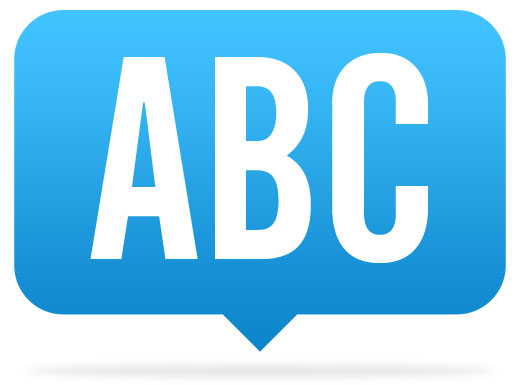Spanish is the second most spoken language in the world. With more than 400 million speakers, it’s the official language in Spain and most countries in Central and South America, including the United States.
This lesson is part of the chapter “Learning Spanish“.

Introduction
Spanish is a Romance language, which means that is an evolved form of Latin, belonging to the branch of Italic languages within the Indo-European family. The close relationship with Latin explains the similarities that Spanish shares with it, like a lot of the pronunciation and the alphabet.
Spanish was very influenced by the Arabic language. The easy part about the language is that it’s pronounced just like we read it, there’s only five vowel sounds and not many variation in the pronunciation when it comes to consonant combinations. The grammar is harder, but you’ll see that speaking it is much easier than you thought.
The Spanish Alphabet
| Letter (lower case) | Letter (upper case) | Pronunciation | English transcription (lower case) | English transcription (upper case) | Example |
|---|---|---|---|---|---|
| a | A | ah | a | A | agua (water) |
| b | B | beh | b | B | lobo (wolf) |
| c | C | ceh | c | C | casa (house) |
| d | D | deh | d | D | día (day) |
| e | E | eh | e | E | ser (to be) |
| f | F | effe | f | F | café (coffee) |
| g | G | geh | g | G | gato (cat) |
| h | H | ah-cheh | h | H | hora (hour) |
| i | I | ee | i | I | ir (to go) |
| j | J | jotah | j | J | jamón (ham) |
| k | K | kah | k | K | kilo (kilo) |
| l | L | eh-leh | l | L | cielo (sky) |
| m | M | eh-meh | m | M | madre (mother) |
| n | N | eh-neh | n | N | nadar (to swim) |
| o | O | oh | o | O | oro (gold) |
| p | P | peh | p | P | padre (father) |
| q | Q | koo | q | Q | queso (cheese) |
| r | R | eh-rre | r | R | rojo (red) |
| s | S | eh-seh | s | S | saber (to know) |
| t | T | teh | t | T | taza (cup) |
| u | U | oo | u | U | usar (to use) |
| v | V | oo-veh | v | V | vivir (to live) |
| w | W | oo-veh doble (doh-bleh) | w | W | web (website) |
| x | X | eh-kees | x | X | México (Mexico) |
| y | Y | ee griega (gree-eh-gah) | y | Y | yo (me) |
| z | Z | zeh-tah | z | Z | zebra (zebra) |
Special characters
We could say that Spanish technically has three special characters. The most special of all is the ñ, which roughly sounds like the ny in English (as in canyon), but it’s not quite the same.
Pay attention to how you tongue should move forward with the middle touching the roof of your mouth instead of the tip, as it’s done in English.
The other two letters are the “che” (ch) and the “elle” (ll), which are actually consonant combinations, but included here as they’re considered letters by a lot of speakers.
| Letter (lower case) | Letter (upper case) | Pronunciation | English transcription (lower case) | English transcription (upper case) | Example |
|---|---|---|---|---|---|
| ñ | Ñ | eh-nyeh | – | – | año (year) |
| ch | Ch | che | – | – | chico (boy) |
| ll | Ll | eh-yeh | – | – | Llave (key) |
Pronunciation
| Letter (lower case) | Pronunciation | Phonetic notation |
|---|---|---|
| a | path | [a] |
| b | ball | [b], can become [β] while in between vowels and before consonants like t, it’s a softer [b]. |
| c | can | [θ] before e or i; otherwise [k]. In a lot of dialects the c before the e and iis pronounced like [s]. |
| d | dice | [d]; becomes [ð] when it’s between two vowels, and rarely when it goes with a consonant. |
| e | bet | [e] |
| f | food | [f] |
| g | got | Usually [g] at the start of the word and sometimes in between, but in that case it can be [ɣ] too. It sounds like an [x] when it goes before i or e. If there’s an u between a g and an e or i, we don’t pronounce it and use [g] or [ɣ] instead: guerra -> [gera]. We don’t skip the u sound when we have “gua” or “guo”. |
| h | hour | The Spanish h is silent, we don’t pronounce it. |
| i | bee | [i]; sometimes sounds like [j] when combined with other vowels. |
| j | No equivalent in English, this sound is usually compared to the one you make when you clear your throat. | [x] |
| k | kid | [k] |
| l | land | [l] |
| m | morning | [m] |
| n | north | [n]; usually [ŋ] when it goes with stop consonants |
| o | boss | [o] |
| p | happy | [p] |
| q | quick | [k] |
| r | No equivalent in English, the sound is made by making the tongue vibrate against the palate. | Trilled/rolled [r]; softer [ɾ] when between two vowels, at the end of words or when there’s a consonant afterwards. We pronounce it as an [r] in between words when we see it written like rr. |
| s | see | [s] |
| t | today | [t] |
| u | you | [u]; [w] when it comes before another vowel |
| v | best | Sounds exactly like the b: [b] or [β] |
| w | wine | [w]; sounds like a b in exceptions like “wáter”. Used in words of foreign origin. |
| x | exact | [ks], [x], [tʃ] or [ʃ] |
| y | yes | [j], [ʎ] or [ʝ], most speakers don’t distinguish these sounds; [i] when there isn’t a vowel afterwards. |
| z | thing | [θ]; [s] in a lot of dialects. |
Special characters
| Letter (lower case) | Pronunciation | Phonetic notation |
|---|---|---|
| ñ | No equivalent in English; sounds like the ny in canyon, but the middle of the tongue moves forward against the roof of the mouth. | [ɲ] |
| ch | chief | [x] |
| ll | yellow | [ʎ]; [ʝ]; it’s mostly pronounced just like the y, and both pronounciations change depending on the region. |
The acute accent
Now, some of you may be wondering what is that little line on the top of some vowels, called “tilde” in Spanish. In English, we can call it accent or acute accent. It may be confusing at first to know when to write it or not, but there are actually some rules and you won’t have a problem if you know where the stress of the word is.
The important thing to know is that there are three kinds of words, and each of them has their rules when it comes to the acute accent. The names of these types of words are in Spanish:
| Agudas | Words that have the stress in the last syllable. If they end in N, S or a vowel, we put an acute accent on the vowel of this last syllable. Example: balón, compás. |
|---|---|
| Llanas | Words that have the stress in the penultimate syllable. We put an accent if the word ends in anything but N, S or a vowel. Example: árbol, clímax. |
| Esdrújulas | There’s a stress in the thrid syllable starting from the last. We always put the acute accent in this case. Example: Electrónica, tónico. |
The acute accent
| Combination | Pronunciation |
|---|---|
| ia | [ja] |
| ie | [je] |
| io | [jo] |
| iu | [ju] |
| ua | [wa] |
| ue | [we] |
| uo | [wo] |
| ui | [wi] |
HTML and Unicode
| Letter (lower case) | HTML code (lower case) | HTML code (upper case) | Unicode (lower case) | Unicode (upper case) |
|---|---|---|---|---|
| a | #97 | #65 | U+0061 | U+0041 |
| b | #98 | #66 | U+0062 | U+0042 |
| c | #99 | #67 | U+0063 | U+0043 |
| d | #100 | #68 | U+0064 | U+0044 |
| e | #101 | #69 | U+0065 | U+0045 |
| f | #102 | #70 | U+0066 | U+0046 |
| g | #103 | #71 | U+0067 | U+0047 |
| h | #104 | #72 | U+0068 | U+0048 |
| i | #105 | #73 | U+0069 | U+0049 |
| j | #106 | #74 | U+006A | U+004A |
| k | #107 | #75 | U+006B | U+004B |
| l | #108 | #76 | U+006C | U+004C |
| m | #109 | #77 | U+006D | U+004D |
| n | #110 | #78 | U+006E | U+004E |
| o | #111 | #79 | U+006F | U+004F |
| p | #112 | #80 | U+0070 | U+0050 |
| q | #113 | #81 | U+0071 | U+0051 |
| r | #114 | #82 | U+0072 | U+0052 |
| s | #115 | #83 | U+0073 | U+0053 |
| t | #116 | #84 | U+0074 | U+0054 |
| u | #117 | #85 | U+0075 | U+0055 |
| v | #118 | #86 | U+0076 | U+0056 |
| w | #119 | #87 | U+0077 | U+0057 |
| x | #120 | #88 | U+0078 | U+0058 |
| y | #121 | #89 | U+0079 | U+0059 |
| z | #122 | #90 | U+007A | U+005A |
Special characters
| Letter (lower case) | HTML code (lower case) | HTML code (upper case) | Unicode (lower case) | Unicode (upper case) |
|---|---|---|---|---|
| ñ | #241 | #209 | U+00F1 | U+00D1 |

Download your free language learning guide
Our free 18-page PDF ebook will teach you how to:
- Get (and stay) motivated learning a new language
- Achieve 80% of your goals with only 20% of the effort
- Make your learning experience more fun than ever
More Spanish lessons
- Numbers in Spanish
- Basic Conversation in Spanish
- Greeting & Farewell in Spanish
- Basic Spanish Verbs
- Basic Spanish Nouns
- Basic Spanish Adjectives
- Colors & Appearance in Spanish
- Countries & Languages in Spanish
- Date & Time in Spanish
- Holidays & Good wishes in Spanish
- Food & Drinks in Spanish
- People & Professions in Spanish
- Family & Friends in Spanish
- Body & Health in Spanish
- Cities & Traffic in Spanish
- Travelling & Leisure time in Spanish
- Spanish videos
- Vocabulary Trainer: Spanish
- Main page: Learn Spanish
Leave A Comment